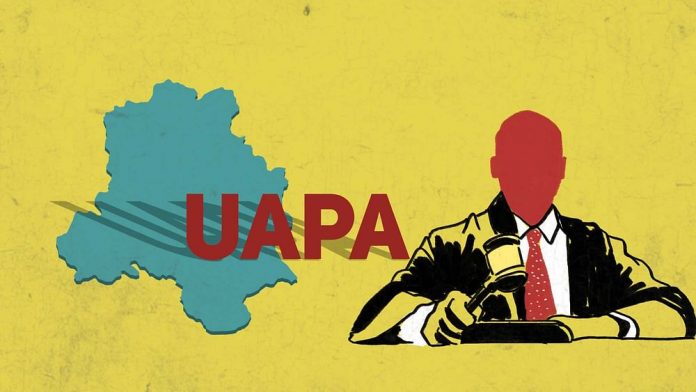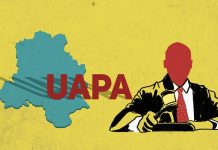This article is authored by Akash Krishnan, a law student from ICFAI Law School, Hyderabad. It discusses in detail the criminal charges levied against Safoora Zargar under the UAPA, 1967 and the legal proceedings hereunder that sparked controversy both nationally and internationally.
Table of Contents
Introduction
On February 23, 2020, northeast Delhi witnessed an event of outraging violence. The violence was the result of the riots that broke out between the supporters and opponents of the Citizenship Amendment Act, 2019. These riots led to the death of over 53 people and injured more than 200 people. On investigation, it was found that these riots were the result of prior conspiracies. During the investigation, the Delhi police arrested several individuals who were suspected of being connected to the conspiracy for the creation and continuation of the riots. Safoora Zargar, a 21-week pregnant student of Jamia Millia Islamia University was one such individual who was suspected of having a connection to these conspiracies. The arrest of Safoora Zargar created a subsequent controversy as she was denied bail by the Indian Courts. This denial of bail was not only criticized by Indian human rights workers but also by UN Bodies.
The Safoora Zargar case
Safoora Zargar is an M.Phil. student of Jamia Millia Islamia University. She is a student activist, leader, and media coordinator of the Jamia Coordination Committee. She was arrested by the Delhi police on 10th April 2020 and was accused of making defamatory and hate speeches against the government on 23rd February 2020. She was also accused of being part of a conspiracy that led to violence in East Delhi on 23.02.2020. She was first presented before the Metropolitan Magistrate on 11th April and was sent to 2-day police custody but was granted bail by the Metropolitan Court on 13th April, but was arrested again later.
On 20th April 2020, Safoora Zargar was additionally convicted under the Unlawful Activities Prevention Act, 1967 as the riots were a predetermined conspiracy. Safoora’s lawyer applied for bail on 18th April 2020 but it subsequently was rejected by the court. Again, Safoora’s advocate applied for bail on 30th May but the same was rejected by the Patiala House Court on the ground that there is an embargo for granting bail under Section 43D (5) of the Unlawful Activities Prevention Act. This bail rejection by the Patiala House Court was heavily criticised both domestically and internationally. A major criticism was that she was 21-weeks pregnant and there was a stage of the pandemic in the state. Thus, bail should have been granted on humanitarian grounds. Also, the order was criticised as it was not able to interpret the provisions of the UAPA 1967 properly. Zargar’s advocate again applied for bail on 23rd June 2020 and was finally granted bail on humanitarian grounds and certain conditions were imposed on the grant of bail. This article analyses the order against the bail applications filed on two different occasions, i.e., rejection of the bail application by the Patiala House Court on 30th May 2020 and the Appeal to Delhi High Court challenging the decision of Patiala House Court.
Before we delve into the analysis of the aforesaid legal proceedings, let us first try and understand the legislation in question, i.e., UAPA 1967.
Unlawful Activities Prevention Act, 1967
It is an Act to regulate and prohibit certain unlawful activities of an individual or association to prevent terrorist activities that disrupt the peace of the State. Following are the provision in question which the Patiala House Court failed to interpret:
Unlawful activities
Unlawful activities have been defined under Section 2(1)(o) as any act committed by an individual or organisation by words or by visual representation:
- That halts the activities of a territory or a part of a territory of India.
- That disrupts the sovereignty or integrity of India.
- That causes disaffection against India.
Punishment for unlawful activities
Section 13 of UAPA states whoever takes part, commits, abets, or advocates any unlawful activities shall be punishable with imprisonment that may extend to 7 years and shall be liable for a fine. If a person assists in conducting any unlawful activity then he shall be liable for imprisonment that may extend to 5 years.
Terrorist act
Section 15 of UAPA states that whoever tries to disrupt the unity, integrity, security, or sovereignty of India or terrorize people or any section of people in India or outside India by the
- use of explosive substances or
- by any hazardous weapons
These acts should result in the loss of life and property and disruption in supplies of essential products.
Punishment for a terrorist act
Section 16 of UAPA states that whoever commits a terrorist act, shall be liable for the death penalty or imprisonment for life if such terrorist act results in the death of any person. In other cases, the punishment includes imprisonment which may extend to five years and may also include a fine.
Punishment for raising funds for a terrorist act
Section 17 of UAPA states that whoever directly or indirectly raises funds from legitimate or illegitimate sources and those funds either fully or partially are used to commit any terrorist act then such person shall be punished with imprisonment not less than 5 years and shall also be liable for a fine.
Punishment for conspiracy, etc
Section 18 of UAPA states that whoever conspires to commit or attempts to commit or abets or entices any terrorist act shall be punishable with imprisonment not less than 5 years and shall also be liable to a fine.
Bail
Section 43D(5) states that no person accused of an offence punishable under Chapters IV and VI of this Act shall be released on bail.
Charges on Safoora Zargar
Safoora Zargar was booked by the Delhi Police under Section 3 and Section 4 of Prevention of Damage to Public Property Act, and Section 13, 16, 17, and 18 of the UAPA. Interestingly only Section 13 comes under the purview of Unlawful Activity whereas Sections 16, 17, and 18 falls under punishments related to terrorist acts of the UAPA 1967.
Proceedings before the Patiala House Court
The Patiala House Court dismissed the bail application by referring to Section 43(D)5 of the UAPA 1967. In its order, the judge was of the view that there was prima facie evidence that Safoora was involved in offences defined under the UAPA.
The contentions of the applicant/accused
The counsel for the accused contended
- That Safoora Zargar is an innocent student who does not agree with the government policies. Simply holding a divergent view on the Citizenship Amendment Act, 2019 does not make her an offender against the State.
- That the accused was involved in a peaceful protest against CAA which is her fundamental right under Article 19 of the Constitution of India. The Right to Peaceful Protest has been recognised in the case of Re-Ramlila Maidan Incident Dt vs Home Secretary And Ors (2012).
- That the accused is an innocent woman and does not have any connection with the riots/violence that occurred in East Delhi.
- That even if the accused intended to protest by peaceful demonstration, the divergent and opposing view against the government policies cannot be deemed as a disaffection to the State. Provisions of the UAPA will not at all be attracted in the case
- That the accused should be granted bail on humanitarian grounds as she was 21 weeks pregnant. Moreover, she suffers from PolyCystic Ovarian Disorder and has a history of urinary tract infections. Her condition could become vulnerable due to the ongoing pandemic COVID-19.
The contentions of the public prosecutor
- The public prosecutor submitted that the accused delivered an inflammatory speech which led to violence and riots in North East Delhi.
- He contended that there is enough evidence on record that establishes a direct connection of the accused to the conspiracy of riots.
- From the statement recorded under Section 161 and 164 of the Criminal Procedure Code, 1973 (CrPC) and available WhatsApp chats on record, it can be inferred that there was a conspiracy to cause blockade on the roads.
- The freedom of speech and expression and for that matter, the right to peaceful protest or demonstration is not absolute and is subject to reasonable restrictions under Article 19 (2) of the Constitution of India.
Order of the Patiala House Court
- The Court relied on the definition of the term ‘disaffection’ that was laid down in the case of Kedar Nath v. The State of Bihar (1982). The Supreme Court, in that case, held that to bring disaffection under the purview of sedition, one needs to establish that the act was of such nature that it would have a tendency to generate disorder or disturb the public peace.
- The Patiala House Court held that mere violence cannot be covered under Section 2(o) of the UAPA. Any activity that can disturb law, order, and public peace and bring a part of a territory or the full territory to stand still, such an act would be covered under Section 2(o) of the UAPA 1967. Therefore, from the statements recorded under Section 161 and 164 of CrPC and available WhatsApp chats on record, it can be inferred that there was a conspiracy to cause blockade on the roads.
- It further held that, since the accused is held as per the UAPA Act there is a statutory embargo in allowing bail under Section 43D(5). Therefore, the bail application was rejected by the Patiala House Court
- The Court further observed that even if no direct violence is attributable to the applicant/accused, she cannot shy away from her liability under the provisions of the said Act.
Analysis
From the order given by the Patiala House Court, it was clear that it lacked interpretation of certain statutes of UAPA. Firstly, the observation made by the Court did not elaborate how the acts of Safoora Zargar were considered terrorist acts under the UAPA. Most interestingly the entire order did not even mention terrorist acts or part IV or VI of the UAPA.
The Patiala High Court has passed its order without providing a rationale for the provisions of the UAPA. Section 43D (5) clearly states that bail cannot be granted for offences recognised under Chapters IV and VI of the UAPA Act. The Court has considered primary evidence showing that the essence of road blockage was pre-planned and the same shall come under the purview of Unlawful Activity but instead, the Court assumed that this conspiracy of road blockage is an act of terror.
The court should realise that every unlawful activity is not a terrorist act. To have clarity among these terms, Section 2(o) and Section 15 has to be looked into and the Order should not be blatantly passed without proper understanding.
Appeal to Delhi High Court challenging decision of Patiala House Court
Safoora Zargar’s advocate on 17th June 2020 applied for bail challenging the order passed by the Patiala House Court at the Delhi High Court. The High Court of Delhi granted bail on humanitarian grounds on the following conditions:
- The accused shall not indulge in activities in which she is investigated
- The accused shall not hamper proceedings of the investigation
- The accused shall remain out of the Delhi NCR region
- If the accused wants to leave the Delhi Territory region she needs to seek permission from the concerned court.
Detention of Safoora Zargar slammed by UN Body
The United Nation Working Group on Arbitrary Detention (UNWGAD) slammed the detention of Safoora Zargar in the light of provision under the Universal Declaration of Human Rights (UDHR) and the International Covenant on Civil and Political Rights (ICCPR). It is to be noted that India is a party to both Conventions. The working group also asked for a response from the Government of India regarding the detention of Safoora Zargar which was completely ignored by the Government of India.
According to UNWGAD, the detention of Safoora Zargar falls under two categories drawn by UNWGAD of arbitrary deprivation of liberty.
Category 1
UNWGAD finds Safoora’s arrest irregular as the complainant itself was a police officer and thus there was a probability of false play. It also noted that the first FIR was filed on the information of a secret informer. After the bail was granted for the first time, she was re-arrested from a different police station on the basis of a different FIR. This act of the police officers was condemned by the working group. The working group considers this as a misuse of power by the police.
Category 2
UNWGAD considers Safoora’s detention as arbitrary. Zargar was just expressing her opinion and exercising her right to peaceful assembly.
The UNWGAD had requested the Government of India to take necessary steps in the Safoora Zargar Situation and continue the proceedings in accordance with the well-established international norms and treaties.
Conclusion
Denial of bail by stretching the provisions of UAPA by side is not what citizens expect from the courts. The citizens of India rely on the equity and justice of courts and if the courts start to pass orders without actually looking at the provision of the laws involved, then the faith of the citizens is at stake. In-depth interpretation of the provisions under criminal law is a necessity and a judgment that is passed with an improper rationale will only increase the problem for innocent persons. India always sets an example of being a generous nation but the court, in this case, overlooked the medical condition of the accused and hurried in passing its order. This shows a negative attitude on part of the judiciary which was slammed not only by Indian activists but even by the UNWGAD. Therefore it is important that the judiciary learns from this case and ensure that such situations do not arise in the future.
References
- https://www.indialegallive.com/constitutional-law-news/courts-news/delhi-hc-grants-bail-to-safoora-zargar-delhi-violence/
- https://images.assettype.com/barandbench/2020-06/ffda1598-54e5-4681-9b19-56b139e7a421/State_vs_Safoora_Zargar___June_4_order.pdf
- https://www.thehindu.com/news/national/un-rights-panel-slams-detention-of-safoora-zargar/article34061744.ece
- https://www.ohchr.org/Documents/Issues/Detention/Opinions/Session89/A_HRC_WGAD_2020_91.pdf
- https://www.business-standard.com/about/what-is-delhi-riots-2020#:~:text=On%20the%20eve%20of%20February,than%20200%20were%20left%20injured
Students of Lawsikho courses regularly produce writing assignments and work on practical exercises as a part of their coursework and develop themselves in real-life practical skills.
LawSikho has created a telegram group for exchanging legal knowledge, referrals, and various opportunities. You can click on this link and join:
https://t.me/joinchat/L9vr7LmS9pJjYTQ9
Follow us on Instagram and subscribe to our YouTube channel for more amazing legal content.
 Serato DJ Crack 2025Serato DJ PRO Crack
Serato DJ Crack 2025Serato DJ PRO Crack










 Allow notifications
Allow notifications



